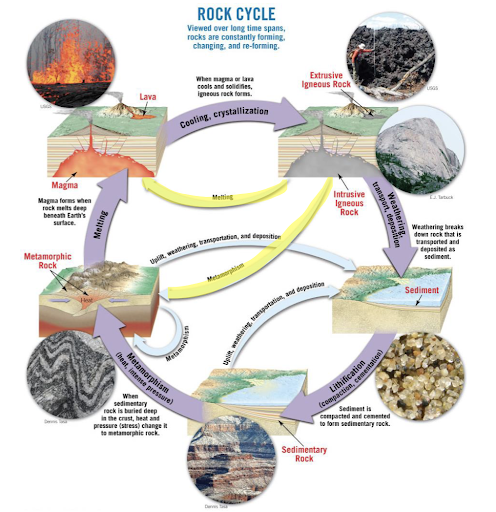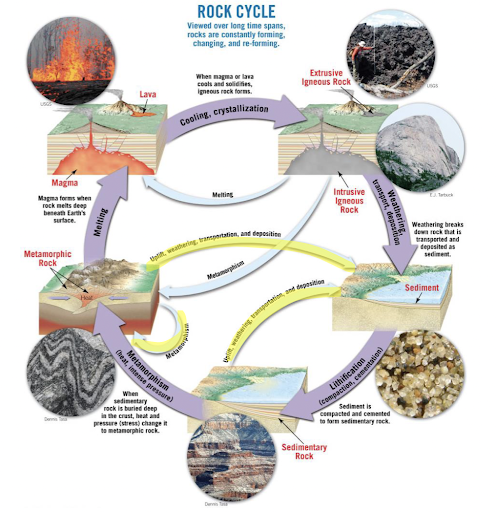Rocks: Types, Formation, and Composition
Rocks
- A rock is a solid aggregate of one or more minerals that have been cohesively brought together by a rock-forming process.
Types of Rocks
- Igneous Rock
- Sedimentary Rock
- Metamorphic Rock
Igneous Rocks
- Igneous rocks form when magma (molten rock) cools and crystallizes, either at volcanoes on the surface of the Earth or while the melted rock is still inside the crust. All magma develops underground, in the lower crust or upper mantle, because of the intense heat there.
- Igneous rocks can have many different compositions, depending on the magma they cool from. They can also look different based on their cooling conditions.
Types of Igneous Rocks
Intrusive (Plutonic) Igneous Rock
Formed when magma cools deep within the Earth’s surface
Cools very slowly as it is in contact with molten rock
Produces coarse-grained igneous rock
Example: Granite
Granite is a coarse-grained igneous rock composed mostly of light-colored, light-density, nonferromagnesian minerals.
The earth's continental areas are dominated by granite and by rocks with the same mineral composition as granite.
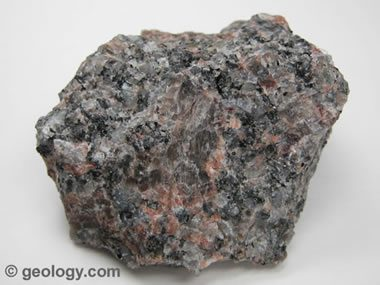
Extrusive (Volcanic) Igneous Rock
- Magma that cools above the Earth’s surface.
- Produces fine-grained igneous rocks.
- This rapid cooling does not allow time for crystals to form.
- Example: Obsidian
- Obsidian has the same chemical composition as granite. However, obsidian has a different texture because it does not have crystals and is volcanic glass. The curved fracture surface is common in noncrystalline substances such as glass.
IGNEOUS ROCKS: “FORMED BY FIRE”
Igneous Compositions
- Magma crystallizes over a temperature range of at least 200°C
- As magma cools, certain minerals crystallize first at relatively high temperatures
- At successively lower temperatures, other minerals begin to crystallize
- Ultramafic, Mafic, Intermediate, Felsic (high to low temperatures)
NAMING IGNEOUS ROCKS
- Granitic rocks
- Composed almost entirely of light-colored silicates – quartz and feldspar
- Also referred to as felsic: feldspar and silica (quartz)
- High silica content (about 70 percent)
- Common rock is granite
- Basaltic rocks
- Contain substantial dark silicate minerals and calcium-rich plagioclase feldspar
- Common rock is basalt
HOW DIFFERENT IGNEOUS ROCKS FORM

Crystal Settling — occurs when the earlier formed minerals are denser than the liquid portion and sink toward the bottom of the magma chamber
- An example of crystal settling and the formation of a zoned magma chamber

Magmatic Differentiation
- The formation of one or more secondary magmas from a single-parent magma
- During the crystallization process, the composition of magma continually changes.
- As crystals form, they selectively remove certain elements from the magma which leaves the remaining liquid portion depleted in these elements
\n COMMON IGNEOUS ROCKS
Some rocks having similar mineral constituents but exhibiting different textures are given different names.
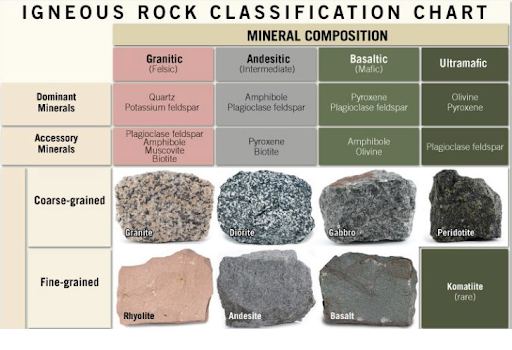

Coarse-grained rocks are plutonic, solidifying deep underground. Fine-grained rocks are volcanic or solidify as shallow, thin plutons. Ultramafic rocks are dark, dense rocks, composed almost entirely of minerals containing iron and magnesium. Although relatively rare on Earth’s surface, these rocks are major constituents of the upper mantle.
Sedimentary Rocks
- Form from material from previously existing rock.
Types of Sedimentary Rocks
- Clastic sediments - Weathered rock materials
- Chemical sediments - Dissolved rock materials
Weathering
- describes the breaking down or dissolving of rocks and minerals on the surface of the Earth.
- Water, ice, acids, salts, plants, animals, and changes in temperature are all agents of weathering.
Samples of Sedimentary Rocks
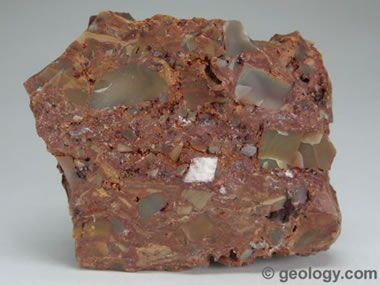 | This is a sample of breccia, a coarse-grained sedimentary rock with coarse, angular fragments. Compare the grain sizes to the centimeter scale. |
|---|---|
 | This is a sample of sandstone, a sedimentary rock that formed from sand grains in a matrix of very fine-grained silt, clay, or other materials. The grains in this sample are mostly the feldspar and quartz minerals, which probably accumulated near the granite from which they were eroded. |
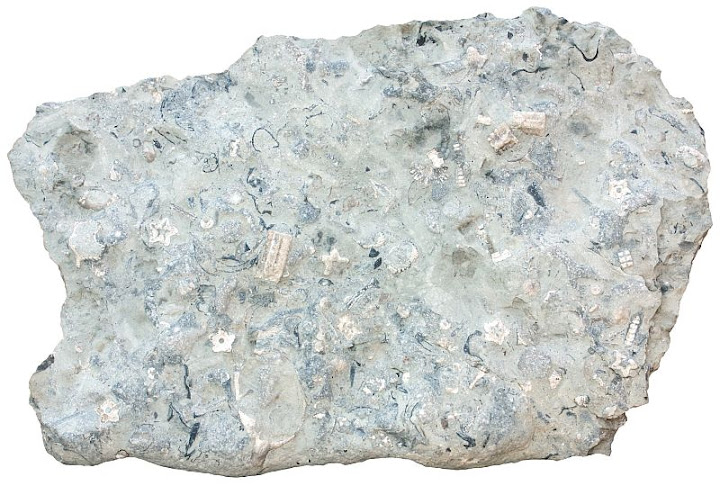 | This is a sample of limestone, a sedimentary rock made of calcium carbonate that formed under water directly or indirectly from the actions of plants and animals. This fine-grained limestone formed indirectly from the remains of tiny marine organisms. |
\n
HOW ARE SEDIMENTARY ROCKS FORMED?
Compaction
- The increasing mass of the sediment layer above creates pressure on the layers below. Eventually, this pressure becomes great enough to compact the existing layers into a cohesive rock layer.
Cementation
- After or during the compaction process, the spaces between the sediment particles become filled with a chemical deposit.
- This deposit holds the compacted layers into a cohesive mass of sedimentary rock.
\n

(A) In compaction, the sediment grains are packed more tightly together, often by overlying sediments, as represented by the bricks.
(B) In cementation, fluids contain dissolved minerals that are precipitated in the space between the grains, cementing them together into a rigid, solid mass.
\n
CLASSIFYING SEDIMENTARY ROCKS
- Detrital rocks
- Material is solid particles
- Classified by particle size
- coarse (gravel-size)
- medium (sand-size)
- fine
- very fine
- Although detrital sedimentary rocks are classified by particle size, in certain cases, the mineral composition is also part of naming a rock.
- Chemical & Biochemical
Derived from material that was once in solution and precipitates to form sediment

Metamorphic Rocks
produced from preexisting igneous, sedimentary, or even other metamorphic rocks

Increasing metamorphic change occurs with increasing temperatures and pressures. If the melting point is reached, the change is no longer metamorphic, and igneous rocks are formed.
METAMORPHIC ROCKS
Foliation
- occurs when the pressure on flat crystal flakes tends to align the flakes into parallel sheets.
- This gives the rock the property of breaking along the planes between the aligned mineral grains in what is known as rock cleavage.
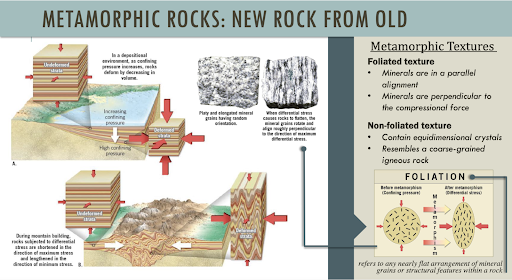
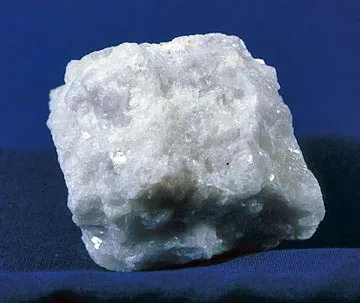 | This is a sample of marble, a coarse-grained metamorphic rock with interlocking calcite crystals. The calcite crystals were recrystallized from limestone during metamorphism. |
|---|
\n
THE ROCK CYCLE
- Earth is a dynamic planet with the surface and interior in a constant state of flux.
- Internal changes alter the surface by moving the Earth’s plates, building mountains.
- Seas advance and retreat over the continents bringing in new materials and taking other materials away.
- Rocks are continually being changed by Earth’s forces.
THE BASIC CYCLE
- What drives the rock cycle?
- Earth’s internal heat
- Weathering and the transport of weathered material
Magma often rises toward the surface because it is less dense than the surrounding rock.
- Magma reaches Earth’s surface → LAVA
- Crystallization or solidification - molten rock cools and solidifies
IGNEOUS ROCKS solidified either beneath the surface or at the surface (following a volcanic eruption)
- Weathering of igneous rocks exposed at the surface → daily influences of the atmosphere slowly disintegrate and decompose rocks
Loose materials → often moved downslope by gravity and then picked up and transported by one or more erosional agents – running water, glaciers, wind, or waves.
Lithification of sediments - “conversion into rock” → SEDIMENTARY ROCKS
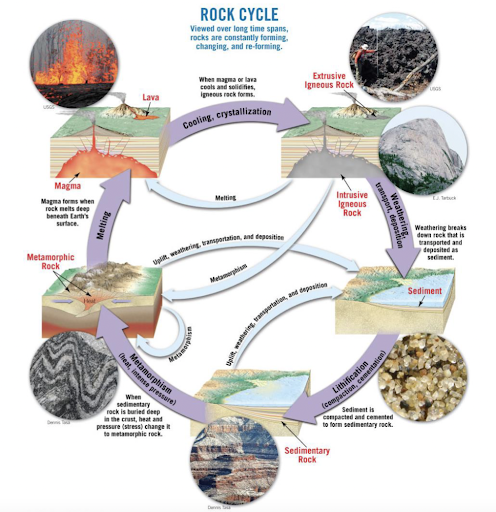
ALTERNATIVE PATHS
(Rocks do not necessarily go through the cycle in the order just described.)
Rather than being exposed to weathering and erosion at Earth’s surface, igneous rocks may remain deeply buried
May be subjected to the strong compressional forces and high temperatures associated with mountain building → transformed directly into metamorphic rocks.
High temperatures and forces associated with mountain building may metamorphose or even melt them
Metamorphic and sedimentary rocks, as well as sediment, do not always remain buried
Overlying layers may be eroded away →material is attacked by weathering processes and turned into new raw materials for sedimentary rocks.
Rocks may be transformed into any other rock type, or even into a different form of the original type.
Rocks may take many paths through the rock cycle
